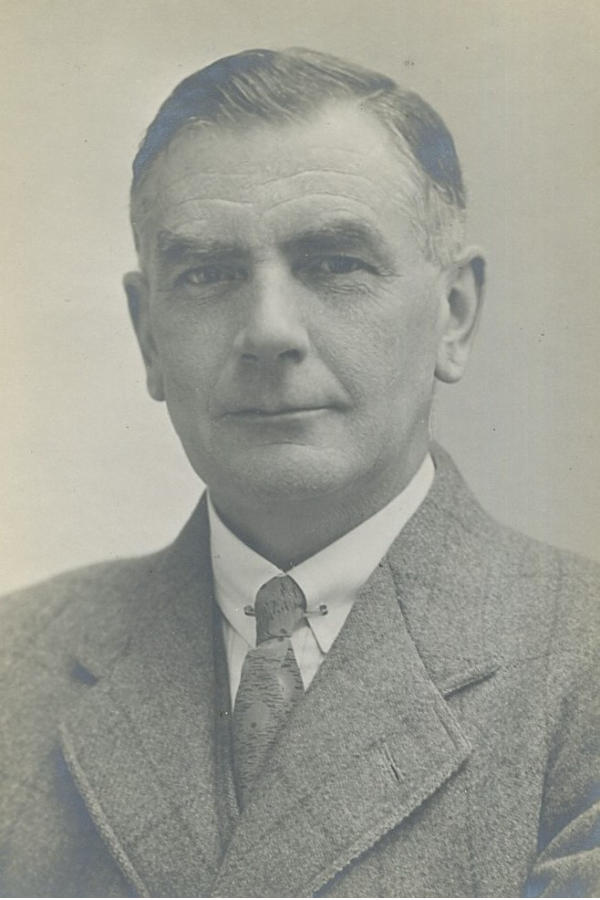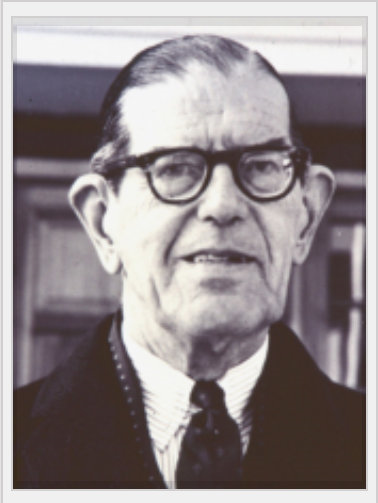
The Founding of the Cirencester
Archaeological & Historical Society
This article by ‘D.A.D.’ (Tony Denning) was originally published in the Society’s Annual Report and Newsletter, No 22 for May 1980, pages 5-9, and reprinted again in Newsletter No 46 in September 2007, pages 17-20. It remains an excellent summary of the very early years of the Society, along with a later short study, ‘CAHS Reviewed’ by Linda Viner, published in the first issue of the Society’s Miscellany, no 1, 1988, pp.1-10.
Tony Denning was a Society stalwart and a respected local historian in his own right. His great love was the history of the theatre locally, and his work is perpetuated in a volume which owed much to his own financial largesse after his death. This study Theatre in the Cotswolds: the Boles Watson Family and the Cirencester Theatre incorporated Tony ‘s research, edited and extended by theatre historian Paul Ranger, and was published by The Society for Theatre Research in 1993 (ISBN 0 85430 054 6). It is now a collector’s item. Here is what Tony had to say about our early days.
The originator of the idea that Cirencester needed a society devoted to its archaeology was Councillor Gordon Young. He was anxious that in an era of increasing change in the town all possible information should be gathered and correlated regarding the history of Roman Corinium and for that purpose a society should be founded, its prime object being to keep records of all Roman remains uncovered during forthcoming building operations.
The town had once had its Naturalists and Archaeological Club and maintained a local secretary to the Bristol and Gloucestershire Archaeological Society but by 1955 a new urgency had touched the subject.
In order to assess the degree of interest he launched his project in a talk to the Rotary Club where his ideas met with support. This initial talk was fully reported in the Gloucestershire Echo and read by many, according to early minutes, but a search for it in the newspaper and elsewhere has remained without result, so no date or details can be quoted here.
Mr Young proceeded to put the proposition to the Urban District Council to learn its attitude and after a positive reaction a special meeting of the U.D.C. was convened in the Council Chamber on Tuesday 25th January 1955.

The Council pledged its support and the Chairman, J.E. Gardner, J.P., suggested the first step be an approach to Professor D. Atkinson, M.A., F.S.A., Curator of the Corinium Museum, as the man with knowledge of sites in the town likely to produce evidence of Roman buildings.
Professor Atkinson welcomed the venture and on 22nd March a meeting was arranged of the Vice-Chairman of the Council, the Town Clerk, Prof Atkinson and Councillor Young. They expressed the strong hope that an archaeological society could be formed and sent out letters to those likely to be interested, inviting them to a meeting. An advertisement was also placed in the Standard.
This broader meeting took place in the Council Chamber on Friday, 29th April, at 6pm and resolved unanimously to proceed with the founding the Cirencester and District Archaeological and Historical Society, the motion being proposed by Mr Hilary Waddington and Lt. Col. Eric Cole. These two last became members of the Society’s original committee together with Gordon Young, Prof Atkinson, Brigadier H. Bullock, Mr H.J. Clappen, Mr G.P. Jackson, Miss Muriel Holland and Mrs E. Clifford who at the time was excavating the important pre-Roman site at Bagendon.
Mr Young was natural choice for Chairman and Mr Jackson of the Bingham Library became the Society’s librarian. Miss June Stacey was the first honorary secretary followed shortly afterwards by Mrs Burton. Miss Holland was honorary secretary from 1957 for fifteen years. The honorary treasurer, Ivan Sheppard, manager of Lloyds Bank, was unable to attend but as the Society had no money his absence did not materially hamper proceedings.
The first committee meeting was held at Dyer Street House by invitation of Lt. Col. Cole on Monday 13th June 1955. After conditions of membership had been settled a programme of summer visits to local sites of archaeological and architectural interest was drawn up, starting with Mrs Clifford’s excavation at Bagendon.
The name of the Society, once it had to be spoken and printed, was lightened by reluctantly dropping the word ‘District’.
Before the September committee meeting a programme of winter lectures had been arranged in the form of a series of twelve fortnightly talks at the Beeches Centre by J. Maiden, M.A. of Bristol University Extra Mural Department. Mr Maiden was a schoolmaster from Stroud and his talks on archaeology, its history and method, were very well attended.
At the September committee meeting the hon. treasurer had appeared and revealed that the kitty held £38 12s 4d, enough for the Society to pay the lecturer and his expenses.
At that same committee meeting a sub-committee was formed whose efforts resulted in a public lecture given on 2nd January 1956 in the Corn Hall by the distinguished leader and populariser of archaeology, Sir Mortimer Wheeler. He spoke on “Digging up the Past”, expanding on the beginnings of social, commercial and agricultural development in Great Britain from the earliest recorded times to the Roman invasion. He took particular pleasure in lecturing in a historical town surrounded by a countryside long inhabited by man.
The public meeting was opened by the Rt. Hon. W.S. Morrison, Cirencester’s M.P. and Speaker of the House of Commons, who was the first president of the Society, and the vote of thanks at the end was proposed by Mr Waddington, who had known Sir Mortimer in India.
By this time the Society had recruited 82 members and 8 junior members so that the kitty had risen to £66 19s 4d, on the strength of which the hon. treasurer agreed that a reception at the King’s Head could be financed to enable the members to meet Sir Mortimer after his Corn Hall lecture.
In view of the widespread local support of the lecture and the wealth of local interest shown, membership increased steadily and Sir Mortimer was made the Society’s first honorary member.

Another memorable lecture arranged by the Society took place on 26th April [1956], this time in the Parish Church, where Mr William I. Croome, C.B.E., M.A., F.S.A., Chairman of the Diocesan Advisory Committee on Faculties and the Care of Churches, talked without notes on the history of the building, pointing to aspects of his subject as he spoke. The audience on that occasion was enlarged by groups from other historical societies in the neighbourhood.
The lecture was recorded by Mr James Turner, Head of the Deer Park Secondary Modern School, and the Society is at present financing the work by Mr Welsford of re-recording the fading tape and making slides of architectural detail in the Church to illustrate Mr Croome’s narrative. In this way it is hoped to preserve the lecture for future enjoyment.
That autumn the suggestion came from Brig. Bullock that the Society should complement the Roman collections in the Corinium Museum by starting a collection covering the subsequent history of the town and Mr Young’s enquiries found a room available at Abberley House, next to the Museum, to house whatever should be donated.
An announcement was made in January 1957 that the Society would hold an exhibition at the Beeches on the 5th to 9th February, illustrative of the history of Cirencester. Under the supervision of Mrs Ruth Waddington eight show cases were filled with collected material and loans and contributions from residents and, such was the local interest aroused, the exhibition had not only to continue for a further week but had to remain open until nine and ten at night. Over one thousand people came and the Manchester Guardian and the B.B.C., amongst others, sent reporters. The success resulted in many bequests to the incipient collection which for want of a suitable positive name became known as the Non-Roman Museum. Owing to other use of the room and a fire the public were not admitted until January 1962, amidst snowstorms and high winds.
Brig. Bullock was also instrumental in having the Parish Registers of Births, Marriages and Deaths covering the years 1560-1700 copied out and typed to make them more readily available for social and economic study.
The Society had, however, not lost sight of its founder’s original purpose and financial support was given in October 1956 to a dig in the grounds of Querns Lane House led by Richard Reece, then still at school in the town.
In May the following year the considerable area in the town centre known as the Dyer Court site was to be developed to make way for the Forum car park, adjacent new roads etc. and the Ministry of Works agreed to spend £200 on trial trenches and other preliminary, exploratory work. Dr Graham Webster, M.A., F.S.A., led the investigation.
The work carried out at Dyer Court made it clear that a more widely based body than a sub-committee of the Society was needed to organise speedy excavation of the many sites in the town calling for early attention. A mosaic floor turned up in Parsonage Field on Watermoor Road where Paternoster House was to be built and the Society of Antiquaries of London undertook to form a Cirencester Excavation Committee to carry out all emergency digs in the town. The new committee met at the Urban District Council’s offices on 15th January 1959 with Councillor Young representing the Society and it became a large body widely representative of local and national archaeological interests.
The balance in the Society’s funds was given to further the Excavation Committee’s plans, which included investigation of the town wall, a quest for the larger public and religious buildings, excavation of cemeteries and a search for traces of the earliest military fort that preceded the building of the Roman town.
Mr Young was about to see the realisation of his object in founding the Society and with an eye to the future strongly advised that its funds should never sink below £100.
Gordon Burdass Young was a man known throughout the district in agricultural circles as well as for his long years of civic service in Cirencester. He was born in London and came to these parts from Hampshire in 1913 to farm at Kemble. In 1924 he moved to Tarlton and four years later took over College Farm which in 1951 he passed to his son who farmed it until this year [1979/1980].
Mr Young worked consistently for the Royal Agricultural Benevolent Institution, becoming at the same time as he was founding CAHS a member of its committee and later its chairman. He was elected to the Urban District Council in 1946 and served on most of its committees until he resigned in 1958. He continued as chairman of the Society he had founded until 1960 when ill health forced him to hand over his work. He died in 1969, at the time of the harvest, aged 77.
His extensive work for old people’s welfare led him to take a great interest in a restoration of the Bowly Almshouses in Watermoor Road in 1958 and the Society has recently, in its twenty-fifth year [1980], paid a small tribute to him by a contribution to another restoration of the same buildings.
D.A.D. [D.A. Denning]